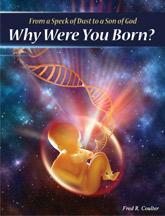Wednesday, March 16, 2021 | [Up]
This year, since the Passover day is a Sabbath, Sunday is the first Holy Day, and the next Sabbath is the Last Holy Day of Unleavened Bread.
The question comes up, how to do properly count Passover? Now it's important to understand first that Jesus Christ was our complete, and perfect unleavened sacrifice. And when the Passover is in the middle of the week, which it was in 30 AD when Jesus was crucified, there is no problem in counting toward Pentecost.
The command in Leviticus 23 says, on the day after the Sabbath. That's the weekly Sabbath, then the next day the Wave Sheaf Offering was offered in the morning on the first day of the week. And in 30 AD there's no problem identifying that Sabbath day, nor did they have a problem identifying the first day of the week. This is the Day that Jesus ascended to be accepted of The Father.
The problem arises in a year like this year, where the Passover day is on a Sabbath. So, you need to understand from Mark 14:12 where it says, "…on the first of the unleavens, when they were killing the lambs," the disciples asked Jesus, where will we prepare the Passover for You to eat?" This is critical to understand because the first of the unleavens is not the first day of the Feast of Unleavened Bread. The first of the unleavens refers to the Passover day.
So, when the disciples saw many of those who had come to Jerusalem for Passover and unleavened bread at their various camp sites and they were killing the Passover lamb, at the very time that they asked Jesus where to prepare for the Passover. This means two things: 1) the Passover day is an unleavened bread day; separate from the seven days of Unleavened Bread.
And what they were watching was those who kept the domestic Passover at their tents, or at their homes were already killing the Passover lambs. And this at the beginning of the 14th day. They were also to eat unleavened bread with it after it was roasted.
So, this makes the Sabbath day an unleavened bread day. Therefore, the next day is the Wavesheaf Offering day. In those years when the Passover falls on the Sabbath day, it is partaken in the evening after sunset when it's getting dark.
So therefore, it is not the day after the Sabbath during the Feast of Unleavened Bread, which in most cases is true. But the Wavesheaf Offering Day must be on the first day of the week, even in the years when the Passover day falls on a weekly sabbath.
The reason is this: Jesus was resurrected from the dead in 30 AD, right at the end of the weekly Sabbath. The next morning, the first day of the week, the day after the weekly Sabbath, He ascended to The Father. He is the firstborn from the dead and the first of the firstfruits.
So, the day to begin the count to Pentecost in the years like this year is this way: Passover day is a separate day of unleavened bread. The next day, the first day of the week, has to be the Wavesheaf Offering Day, because Jesus is the firstborn and the first of the firstfruits. Some people erroneously begin to count to Pentecost after the 7th day of Unleavened Bread in years like this year. But they fail to realize that the first day of the week after the seventh day of Unleavened Bread, which falls on a weekly Sabbath, means that the wavesheaf would be offered outside the Feast of Unleavened Bread. And thus, would negate the sinlessness of Jesus' life, sacrifice and resurrection.
So, what it means is this: Passover is to be taken this year the evening of March 26th as it is getting dark. The Night To Be Much Observed is in the evening of March 27th, which is right after Sabbath of the 27th. Then the first day of the count is March 28th, which is the first day of the week.






